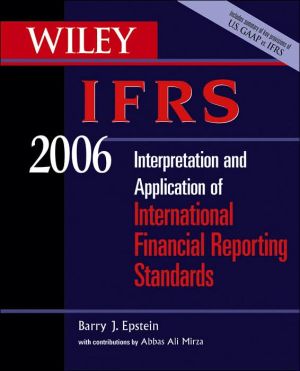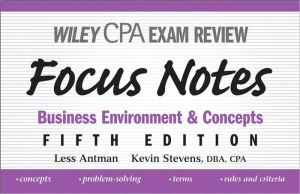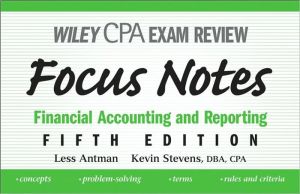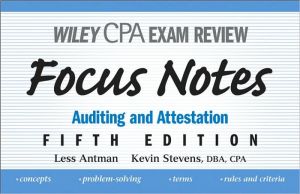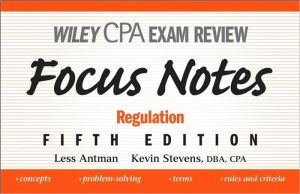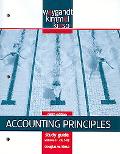Wiley IFRS: Interpretation and Application of International Financial Reporting Standards 2006
International Financial Reporting Standards (IFRS), formerly known as International Accounting Standards (IAS), have received increasingly favorable attention in recent years, beginning with the endorsement by the International Organization of Securities Commissions (IOSCO) and then, especially, after the European Union mandated use of the IFRS by all EU Member States' publicly held companies, beginning in 2005. Thus, as over 7,000 companies in the twenty-five Member States prepare their...
Search in google:
International Financial Reporting Standards (IFRS), formerly known as International Accounting Standards (IAS), have received increasingly favorable attention in recent years, beginning with the endorsement by the International Organization of Securities Commissions (IOSCO) and then, especially, after the European Union mandated use of the IFRS by all EU Member States' publicly held companies, beginning in 2005. Thus, as over 7,000 companies in the twenty-five Member States prepare their consolidated financial statements in early 2006, they will be making a major, and possibly difficult, transition to the IFRS from various predecessor national GAAP standards. Other major nations, including Russia, China, and Australia are also transitioning to IFRS, and both the U.S. and U.K. standard setters are committed to a process of convergence with the IFRS. Thus, there is accelerating momentum toward worldwide embrace of these financial reporting standards-which a few short years ago were virtually unknown to most major reporting entities. IASC, predecessor of the current IASB, began its efforts about thirty years ago, and enjoyed modest success. Many of the national standards mandated by developing nations' standard setters already were either closely based on the IFRS or were direct endorsements of the international standards; now, with the most highly developed nations rushing to embrace the IFRS, there may soon be a truly worldwide set of financial reporting standards. Wiley IFRS 2006 is the compact yet truly comprehensive reference guide that accountants and auditors can rely upon as they gain an understanding of the intricacies of financial reporting under the IFRS.To facilitate this process, Wiley IFRS 2006 contains many real-world examples, illustrative key financial reporting and disclosure issues, a comprehensive disclosure checklist, an updated, detailed comparison between the IFRS and U.S. GAAP, and a thorough explanation of the special requirements of first-time adoption of IFRS reporting. All IFRS and related pronouncements through IFRS 7 are covered in elaborate detail, with interpretive guidance provided by seasoned practitioners with global experience in financial reporting. The up-to-date and exhaustively edited 2006 edition contains coverage of important and complex new requirements such as: * IFRS 1, First-Time Adoption of International Financial Reporting Standards * IFRS 2, Share-Based Payment * IFRS 3, Business Combinations * IFRS 4, Insurance Contracts * IFRS 5, Noncurrent Assets Held for Sale and Discontinued Operations * IFRS 6, Exploration for and Evaluation of Mineral Resources * IFRS 7, Financial Instruments: Disclosures The 2006 edition continues detailed coverage of all previously issued IAS standards, including the recently revised financial instruments and hedge accounting standards IAS 32 and IAS 39. New for 2006 is a comprehensive treatment of present value concepts and computations, which are increasingly important given the ongoing incorporation of fair value into financial statement measurement requirements. Many new illustrative examples have been added to all chapters. Other complex areas receiving expansive coverage are: * IAS 2, Inventories * IAS 17, Accounting for Leases * IAS 18, Revenue * IAS 19, Employee Benefits * IAS 27, Consolidated and Separate Financial Statements * IAS 30, Disclosures in the Financial Statements of Banks and Similar Financial Institutions * IAS 36, Impairment of Assets * IAS 38, Intangible Assets * IAS 41, Agriculture
1. Introduction to International Financial Reporting Standards. Appendix A: Current International Accounting Standards (IAS/IFRS) and Interpretations (SIC/IFRIC). Appendix B: Case Study Illustrating Possible Supplemental Treatments under the IOSCO’s Recommendations. Appendix C: US GAAP Reconciliation and Restatement. Appendix D: Use of Present Value in Accounting. 2. Balance Sheet. 3. Statements of Income, Changes in Equity, and Recognized Income and Expense. 4. Cash Flow Statement. 5. Cash, Receivables, and Financial Instruments. 6. Inventory. 7. Revenue Recognition, Including Construction Contracts. Appendix: Accounting under Special Situations—Guidance from US GAAP. 8. Property, Plant, and Equipment. 9. Intangible Assets. 10. Interests in Financial Instruments, Associates, Joint Ventures, and Investment Property. Appendix: Schematic Summarizing Treatment of Investment Property. 11. Business Combinations and Consolidated Financial Statements. 12. Current Liabilities, Provisions, Contingencies, and Events After the Balance Sheet Date. 13. Financial Instruments—Long-Term Debt. 14. Leases. Appendix A: Special Situations Not Yet Addressed by IAS 17. Appendix B: Leveraged Leases under US GAAP. 15. Income Taxes. Appendix: Accounting for Income Taxes in Interim Periods. 16. Employee Benefits. 17. Stockholders’ Equity. Appendix A: Illustration of Financial Statement Presentation. Appendix B: Additional Guidance under US GAAP. 18. Earnings Per Share. 19.Interim Financial Reporting. 20. Segment Reporting. 21. Changes in Accounting Policies and Estimates, and Corrections of Errors. 22. Foreign Currency. 23. Related-Party Disclosures. 24. Specialized Industries. 25. Inflation and Hyperinflation. Appendix: Monetary vs. Nonmonetary Items. 26. Government Grants. 27. First-Time Adoption of International Financial Reporting Standards. Appendix A: Disclosure Checklist. Appendix B: Illustrative Financial Statements Presented under IFRS. Appendix C: Comparison of IFRS and US GAAP. Index.
